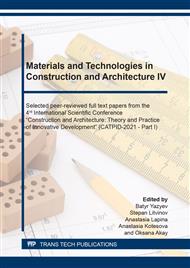[1]
Ministry of RF Economic Development. Picture of business activity. January 2019. Information on http://www.economy.gov.ru.
Google Scholar
[2]
Modern building technologies: monograph, Edited by S.G. Golovnev, Chelyabinsk: publishing center SUSU, (2010).
Google Scholar
[3]
S.N. Leonovich, D.A. Litvinovsky, O. Yu. Chernyakevich, A.V. Stepanova, Strength, crack resistance and durability of structural concrete under temperature and corrosion effects: monograph, BNTU, Minsk, (2016).
Google Scholar
[4]
V.M. Chelnokova, N.V. Balberova, Quality management: textbook, SPbGASU, SPb., (2010).
Google Scholar
[5]
V.G. Khozin, Polymers in construction - real boundaries and prospects for effective use, Scientific Internet Journal Polymers in Construction,. 1 (2014) 9-26.
Google Scholar
[6]
А.Yu. Popov, K.K. Gosina, I.V. Petrov and others, Classification, composition, advantages and disadvantages of composite materials, Omsk Scientific Bulletin. 3(143) (2015) 42 –45.
Google Scholar
[7]
N.Yu. Anakhin, N.G. Groshev, D.A. Onopriichuk, Research of building materials, Territory of Science. 6 (2016) 120 – 124.
Google Scholar
[8]
R.М. Aseeva, Reducing the flammability of polymeric materials, Znaniye, Moscow, (1981).
Google Scholar
[9]
Buildings, structures, and their resistance to fire, Edited by V.M. Roitman, Academy of State Fire Service of the Ministry of Emergency Situations of Russia, Moscow, (2013).
Google Scholar
[10]
V.I. Korchagin, S.A. Andreeva, Analysis of environmental problems of the use of polymer building materials, Building materials of the XXI century., 6 (2010) 22-23.
Google Scholar
[11]
G.I. Grinfeld, The performance characteristics of autoclaved aerated concrete of the average density grade D400, Online magazine Construction of unique buildings and structures,. 5(10) (2013) 28-57.
Google Scholar
[12]
K.V. Talantova, N.M. Mikheev, Steel fiber concrete and structures based on it. Monograph, St. Petersburg State University of Railways, St. Petersburg, (2014).
Google Scholar
[13]
S.N. Smorodin, V.N. Belousov, V.Yu. Lakomkin, Energy saving methods in power, technological installations and construction: textbook, SPbGTURP, SPb., (2014).
Google Scholar
[14]
K.B. Ryabtseva, To the question of the future of panel houses of mass development at the end of the last century, Sb.tr. Modern construction,, SPb. 2(3) (2019) 148-154.
Google Scholar
[15]
SP 50.13330.2012, Thermal protection of buildings. Updated edition of SNiP 23-02-2003. Official edition. M., 2012. – p.95.
Google Scholar
[16]
L.V. Morgun, A. Yu. Bogatina, V.N. Morgun, Modern polyfunctional gas-filled concrete, Building materials science: present and future. 274-279. Information on https://mgsu.ru/resources/izdatelskayadeyatelnost/izdaniya/izdaniya-otkr-dostupa/.
Google Scholar
[17]
M. B. Youssef, K. Miled, J.Néji, «Mechanical properties of non-autoclaved foam concrete: analytical models vs. experimental data», European Journal of Environmental and Civil Engineering, 24(4) (2020) 472-480.
DOI: 10.1080/19648189.2017.1398108
Google Scholar
[18]
V.N. Morgun, L.V. Morgun, D.A. Votrin, Influence of the diameter of dispersed reinforcement on the speed of the phase transition, Building materials. 11 (2018) 27-30.
Google Scholar
[19]
Yu.V. Pukharenko, V.Yu. Golubev, About the viscosity of destruction of fiber-reinforced concrete, Bulletin of civil engineers. 3(16) (2008) 80-83.
Google Scholar


